Thursday Dec 11, 2025
Thursday Dec 11, 2025
Wednesday, 29 May 2019 00:00 - - {{hitsCtrl.values.hits}}

This article is the fourth in a series of articles on delimitation of geographical boundaries in Sri Lanka. Following on the third article, ‘Smaller electoral units needed to serve the people better’ (Sunday Island of 10 February and Daily FT of 20 May), this too will focus on electoral boundaries but, more specifically, on the topic of multi-member electorates.
There is a perception that multi-member electorates are the best option for minority communities to be represented in an elected body. However, historical evidence has shown that this is not always the case.
This article argues that when there are significant geographical concentrations of a minority community in an electoral district, then the objective of that minority representation is more likely to be achieved by concentrating such a minority community within single-member electorates in those geographical areas.
What is a multi-member electorate?
In electoral districts where there is a significant minority community of interest that differs from the majority of the population in that district, whether by a) shared racial or ethnic background, b) shared history and/or culture c) shared religion d) shared language e) shared socio-economic or income status f) shared economic activities g) shared gender, or any other differentiating factor, it is important that such a minority community is represented in any elected body, whether in Parliament, a Provincial Council or a Local Authority.

For example, in Gampaha District, in addition to the majority Buddhist (71%), there is a significant Roman Catholic (20%) minority community. In Nuwara Eliya District, in addition to the majority Estate (54%), there is a significant rural (41%) minority community, while in the Trincomalee District, in addition to the majority Moors (42%), there are significant Tamil (31%) and Sinhala (27%) minority communities.
Representation of such minority communities could be achieved in two ways, either a) by concentrating that minority community in specific electorates, if possible, or b) by creating electorates, which return more than one member to the elected body who could represent the diverse communities of interest in that electorate.
Such electorates that return multiple members (historically two or three) are called multi-member electorates. A multi-member electorate, in theory, provides an opportunity for a second, and sometimes third, member to be elected from minority communities different to the community represented by the first winning member, who may represent the majority community.
Key principles used in the delimitation of electorates
As mentioned in a previous article, the principle of unbiasedness in delimitation of electorates recognises the need for representation of the multi-cultural and socio-economic diversity of Sri Lanka’s people in any elected body.
This principle is enshrined in Section 3A(4)(a) of the Provincial Councils Elections (Amendment) Act No.17 of 2017. In many election laws, multi-member electorates provide for minority communities, which reflect the multi-cultural and socio-economic diversity of a country, to be represented in an elected body. The Provincial Councils Elections Amendment Act 2017, Sections 3A(5) and 3A(6) provide for creating multi-member electorates for this express purpose.
As importantly, the principle of inclusiveness and representativeness (one person-one vote principle) requires the delimitation process to target equal population per elected representative (minimise disproportion among electorates) in any electoral district. This principle is enshrined in Section 3A(4)(b)(i) of the Provincial Councils Elections (Amendment) Act No.17 of 2017.
The representation of diverse communities should be achieved to the best extent possible, without compromising on any other aspects of equitable representation.
Under the one person-one vote principle, a two-member or three-member electorate in any electoral district should represent a population that is double or triple the population represented in a single-member electorate. Then, each elected member represents an equivalent number of persons in that district.
For example, if a single-member electorate has 50,000 people, then a two-member electorate should have approximately 100,000, so that each elected member represents 50,000 people of that district. Hence, assuming three candidates for the two seats, a minority community would need at least 33,000 population to elect a representative in a two-member electorate, in comparison to 25,000 in a single member electorate with two candidates. Thus, a multi-member electorate that combines the population of more than one single-member electorate will not bring any advantage to a minority community to elect their representative, unless they amount to a significant share of the much larger population in the multi-member electorate.
In fact, the mere creation of multi-member electorates, without a safety mechanism to fulfil the requirements of a minority community of interest, could result in a multi-member electorate returning multiple representatives of the majority community, without a single representative of the minority community of interest.
Meanwhile, there appears to be a strong misconception that the mere creation of a multi-member electorate always gives an advantage to a minority community. This misconception was observed in the reaction to the Report of the Delimitation Committee for the Delimitation of Electorates in Provincial Councils of February 2018. In fact, the existence of multi-member electorates does not necessarily achieve minority representation. A few historical examples that either achieved or did not achieve the required objective are given below:
Concluding observations
The above examples provide evidence that multi-member electorates do not necessarily ensure the desired objective. Hence, in electoral districts where there are significant numbers of a minority community of interest in the population, concentrating that community within specific electorates in the region, wherever possible, without resorting to multi-member electorates, may better achieve the objective of elected members representing different minority communities of interest in that district.
Furthermore, as argued in my previous article, smaller electoral units serve the citizens better than larger ones. In two-member and three-member electorates, respectively, two or three members represent a population that is double or triple the population in a single member electorate.
In such situations, two or three times as many people have to choose which of two or three members to approach for their needs, while each member, being responsible for the entire electorate, must cater to the needs of twice or thrice as many people as in a single-member electorate. In this situation, often, the people get neglected, as, on the one hand, they are too distant from their representatives and, on the other, their numbers are too overwhelming for meaningful action on the part of their representatives.
Based on detailed study of past election outcomes of multi-member electorates, the Report of the Delimitation Committee for the Delimitation of Electorates in Provincial Councils of February 2018, addressed this matter by making every effort to concentrate a minority community within specific electorates in the electoral district, wherever possible, without resorting to larger multi-member electorates, to better achieve representation of minority communities of interest, in particular, as well as to achieve better service to the people, in general. The outcome of those efforts remains to be seen.
(Since November 2015, the author has been a member of the 3-member Delimitation Commission, one of nine Independent Commissions appointed by the President under the 19th Amendment to the Constitution. She was also a member of the Delimitation Committee for Provincial Council Elections appointed by the President in October 2017, which completed its task in February 2018, within its mandate of four months. She retired as Assistant Governor from the Central Bank of Sri Lanka in 2007.)